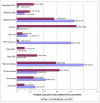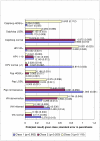Visual inspection with acetic acid as a cervical cancer test: accuracy validated using latent class analysis
- PMID: 17663796
- PMCID: PMC2018715
- DOI: 10.1186/1471-2288-7-36
Visual inspection with acetic acid as a cervical cancer test: accuracy validated using latent class analysis
Abstract
Background: The purpose of this study was to validate the accuracy of an alternative cervical cancer test - visual inspection with acetic acid (VIA) - by addressing possible imperfections in the gold standard through latent class analysis (LCA). The data were originally collected at peri-urban health clinics in Zimbabwe.
Methods: Conventional accuracy (sensitivity/specificity) estimates for VIA and two other screening tests using colposcopy/biopsy as the reference standard were compared to LCA estimates based on results from all four tests. For conventional analysis, negative colposcopy was accepted as a negative outcome when biopsy was not available as the reference standard. With LCA, local dependencies between tests were handled through adding direct effect parameters or additional latent classes to the model.
Results: Two models yielded good fit to the data, a 2-class model with two adjustments and a 3-class model with one adjustment. The definition of latent disease associated with the latter was more stringent, backed by three of the four tests. Under that model, sensitivity for VIA (abnormal+) was 0.74 compared to 0.78 with conventional analyses. Specificity was 0.639 versus 0.568, respectively. By contrast, the LCA-derived sensitivity for colposcopy/biopsy was 0.63.
Conclusion: VIA sensitivity and specificity with the 3-class LCA model were within the range of published data and relatively consistent with conventional analyses, thus validating the original assessment of test accuracy. LCA probably yielded more likely estimates of the true accuracy than did conventional analysis with in-country colposcopy/biopsy as the reference standard. Colposcopy with biopsy can be problematic as a study reference standard and LCA offers the possibility of obtaining estimates adjusted for referent imperfections.
Figures


References
-
- ACOG Executive Board, American College of Obstetricians and Gynecologists, Society of Obstetricians and Gynaecologists of Canada, Central American Federation of Associations and Societies of Obstetrics and Gynecology, Gynaecologic Oncologists of Canada, Society of Canadian Colposcopists, Society of Gynecologic Oncologists, Royal College of Obstetricians and Gynaecologists ACOG statement of policy: cervical cancer prevention in low-resource settings. Obstet Gynecol. 2004;103:607–609. - PubMed
-
- Bishop A, Sherris J, Tsu VD, Kilbourne-Brook M. Cervical dysplasia treatment: key issues for developing countries. Bull Pan Am Health Organ. 1996;30:378–86. - PubMed
-
- Belinson J, Qiao YL, Pretorius R, Zhang WH, Elson P, Li L, Pan QJ, Fischer C, Lorincz A, Zahniser D. ShanxiProvince cervical cancer screening study: a cross-sectional comparative trial of multiple techniques to detect cervical neoplasia. Gynecol Oncol. 2001;83:439–44. doi: 10.1006/gyno.2001.6370. - DOI - PubMed

